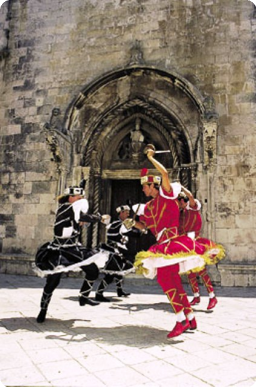

Korčula/island of Korčula
Korčula/island of Korčula 
Moreška means Moorish. The word is derived from the Spanish adjective Morisco or the Italian Moresco. It is a matter of conjecture whether the dance came to the Adriatic directly from Spain through roving Spanish sailors, or from Sicily or Italy when Dalmatia formed part of the Venetian Republic. Whether it was originally a Moorish dance or a Spanish one, inspired by the struggle of Spanish Christians against the Moors is also debatable, though the latter seems the most likely. We do know for certain that it is one of the oldest traditional European dances still performed, and that records exist of it being danced in Lerida in 1156 in a form portraying a Christian and National victory over the Moors and their expulsion from Aragon.
From the 12th century, and particularly in the 16th and 17th centuries, the dance spread to many Mediterranean countries: to Italy, Corsica, Sicily, Malta, France and, through Spanish trade, to Flanders, Germany and even to England. It was subject to frequent local variations with regard to plot, protagonists and eventually also to form. In Corsica, it was danced by eighty swordsmen on each side, armed with two swords apiece, who did battle for the town of Mariana to the music of a solo violin. In Elba, the engagement was between Christians and Turks, while in other places it was between Arabs and Turks. Sometimes the damsel in distress was a white maiden of royal blood, sometimes a Turkish or Moorish one of equal innocence and beauty. In Ferrara, a dragon was introduced who tried to devour the damsel and there were many later versions which degenerated from the original war-dance (basically sword practice and a 'keep-fit' class for the warriors of small islands or coastal garrisons for whom good swordsmanship and alertness meant survival) into a form of folk drama, and eventually into the dance interludes of pastoral plays and Italian opera. In Germany, the Moreška, though called Moriskentanze, became a mere collection of local folk dances and in England the Morris (i.e. Moorish) dancers threw away their swords and substituted long wooden sticks, which they fought with and over which they hopped. In most of the Mediterranean, the Moreška survived until the end of the 18th century, and in Italy and Dalmatia till the close of the 19th.
Today, Korčula is the only island where it is still danced with real swords in its original war-dance form and where it has enjoyed a proud and almost unbroken tradition for over four centuries, though the text, music and pattern of the dance have been slightly altered and shortened over the years (it used to last for two hours!)
Source: http://www.visitkorcula.net/
Video
Current news
 Macrocruise charter agency
Additional discount on the boat rental price of betw
Macrocruise charter agency
Additional discount on the boat rental price of betw


























